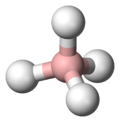Borohydride
Borohydride refers to a class of chemical compounds that are characterized by the presence of a boron (B) atom bonded to four hydrogen (H) atoms, forming the borohydride anion (BH4−). These compounds are widely used in various chemical reactions, particularly as reducing agents in organic and inorganic chemistry due to their ability to donate hydride ions (H−).
Overview
Borohydrides are known for their versatility and efficiency in reducing a wide range of organic compounds, including aldehydes, ketones, and carboxylic acids, to their corresponding alcohols. They are also employed in the reduction of esters and amides to alcohols and amines, respectively. The most commonly used borohydride is sodium borohydride (NaBH4), but other derivatives such as lithium borohydride (LiBH4), potassium borohydride (KBH4), and calcium borohydride (Ca(BH4)2) are also significant.
Chemistry
The chemistry of borohydrides is centered around the borohydride ion (BH4−), which acts as a source of hydride ions. These ions are highly nucleophilic, making them effective in reducing electrophilic compounds. The reactivity and selectivity of borohydride reductions can be influenced by the choice of solvent, temperature, and the specific borohydride compound used.
Synthesis
Borohydrides can be synthesized through various methods, including the direct reaction of diborane (B2H6) with alkali metals or alkali metal hydrides. Another common method involves the reduction of borate salts with hydride donors such as lithium aluminium hydride (LiAlH4).
Applications
In addition to their widespread use in organic synthesis, borohydrides find applications in other areas such as:
- Fuel cells, where they serve as hydrogen storage materials.
- Pharmaceuticals, in the synthesis of various drugs.
- Material science, for the preparation of metal borides and other boron-containing compounds.
Safety and Handling
Borohydrides are generally stable under normal conditions but can be highly reactive with water, releasing hydrogen gas and potentially causing fire or explosion. Proper safety measures, including the use of inert atmospheres and dry solvents, are essential when handling these compounds.
Environmental Impact
The environmental impact of borohydrides is relatively low compared to other chemical reagents. However, the handling and disposal of these compounds should be conducted in a manner that minimizes exposure to the environment and complies with local regulations.
Transform your life with W8MD's budget GLP-1 injections from $125.
W8MD offers a medical weight loss program to lose weight in Philadelphia. Our physician-supervised medical weight loss provides:
- Most insurances accepted or discounted self-pay rates. We will obtain insurance prior authorizations if needed.
- Generic GLP1 weight loss injections from $125 for the starting dose.
- Also offer prescription weight loss medications including Phentermine, Qsymia, Diethylpropion, Contrave etc.
NYC weight loss doctor appointments
Start your NYC weight loss journey today at our NYC medical weight loss and Philadelphia medical weight loss clinics.
- Call 718-946-5500 to lose weight in NYC or for medical weight loss in Philadelphia 215-676-2334.
- Tags:NYC medical weight loss, Philadelphia lose weight Zepbound NYC, Budget GLP1 weight loss injections, Wegovy Philadelphia, Wegovy NYC, Philadelphia medical weight loss, Brookly weight loss and Wegovy NYC
|
WikiMD's Wellness Encyclopedia |
| Let Food Be Thy Medicine Medicine Thy Food - Hippocrates |
Medical Disclaimer: WikiMD is not a substitute for professional medical advice. The information on WikiMD is provided as an information resource only, may be incorrect, outdated or misleading, and is not to be used or relied on for any diagnostic or treatment purposes. Please consult your health care provider before making any healthcare decisions or for guidance about a specific medical condition. WikiMD expressly disclaims responsibility, and shall have no liability, for any damages, loss, injury, or liability whatsoever suffered as a result of your reliance on the information contained in this site. By visiting this site you agree to the foregoing terms and conditions, which may from time to time be changed or supplemented by WikiMD. If you do not agree to the foregoing terms and conditions, you should not enter or use this site. See full disclaimer.
Credits:Most images are courtesy of Wikimedia commons, and templates, categories Wikipedia, licensed under CC BY SA or similar.
Contributors: Prab R. Tumpati, MD



